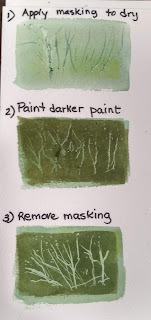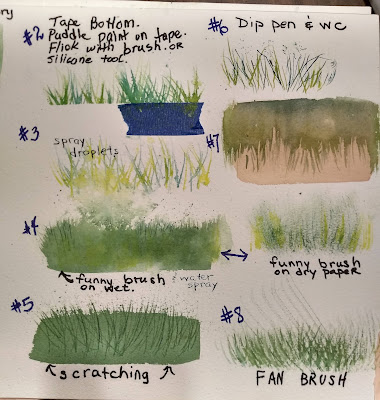What is it about GREEN that strikes fear into the hearts of the most noble watercolorist? Orange...no problem. You want purple? Easy peasy. But green?
I was driving on the interstate and realized how green those highway signs are. They showed up so well even against a background of trees and bushes. And it clicked. That green doesn't exist in the natural world, at least not around here. It's so in-your-face green that it is out of place and shows up anywhere.
It also occurred to me that I've seen paintings of landscapes using that kind of green and feeling very uncomfortable. Not that I personally would do that.....
In landscapes and florals, you want your greens to look natural and to harmonize...look "right" together. Some greens will be used to show sunlight, others for shade; some for distance, some for foreground. Maybe I've been guilty of using one green for a bush, then shading it with a different green, but it somehow didn't look like the shade was part of the bush, more like a hole in the bush.
A good place to start is by training yourself to see things how they are, not how your kindergarten brain wants to see it.
So this blog is about three parts:
1. mixing your own greens
2. being able to duplicate a green in a picture, scene, or item using knowledge learned from creating a chart of greens
3. Using your greens to make a simple picture of your own using just 3 colors.
LEARN WHAT GREENS YOU CAN MAKE ON YOUR OWN
This method is painting "wet on wet," which means you wet the paper first, drop in one color, then drop in another, then allow them to blend together...maybe with a few encouraging swipes of the brush.
Create a grid on a piece of paper, at least 9 x 12, using masking tape to separate the columns.
I like to have at least 10 rectangles, and I like them to be large enough to really see the effect of the colors mingling wet on wet.
Choose some blues and yellows. Wet a space. Apply one of the yellows on one side (I chose left) and a blue for the right. Allow them to mingle together until they make several shades of green. LABEL each time you do this. Choose different blue and yellow for each rectangle. For example, on the one below, the first space is French Ultramarine and Hansa Yellow. The one right of that is French ultramarine and Nickle Azo Yellow (a more orange yellow)
second row: Pthalo blue and hansa yellow; french ultramarine and quinacridone gold
3rd row:Indigo and hansa yellow; pthalo and quin gold
4th row: cerulean and hansa; cerulean and quin gold
5th row: A bit of a surprise: paynes gray and hansa; neutral tint and hansa. They make a lovely olive color... who knew? But Paynes gray is made out of blue and black, so adding yellow to it makes sense to make a green. Neutral tint is made from lamp black, pthalo blue, and quin violet, so adding some yellow should make a green of sorts.
The important thing is to experiment with the colors you have and see what you can do with them. You don't need a huge selection....just need to know what you can do with what you have.
Next step is to choose a green and try to neutralize it (that means lower the intensity or gray it down) with red; then try orange; then try purple. You should come up with some interesting greens that are much more natural looking.
If you prefer mixing color on the palette, try that also. You will see the color will be flatter and not as variegated and won't have the granulation you see doing wet on wet.
TRY TO DUPLICATE THE COLOR YOU SEE
Using the references below (or your own reference, pictures cut from a magazine) identify as many green shades as possible. Then try to duplicate that color. You can, as we did in class, use leaves or grass cut from your yard to try to duplicate the color. Try to paint the color of the back of a leaf, which is usually grayer. Use your chart to compare and get as close to the color as possible, then either add red or violet to tone it down or darken. You may need to thicken or water down your paint to get closer to the color you want.
Let's use that second picture. To try to duplicate that yellow green, you might observe that hansa (or a lemon) yellow and cerulean make a beautiful spring green that you can add a little extra yellow to. That should bring you close to that color. The shaded underside would have to have some blue added to create that darker green.
For the foliage on the left, you might begin with a French ultramarine (not such a spring color) and yellow, then add a violet to make it much duller, more olive in color.
Try several choices to duplicate some of the greens. Record your results.
leaves from my yard
Look at the color wheel:
The yellow that leans to green (such as hansa and lemon) and the blue that leans to green (such as pthalo, cerulean) will make your pretty pretty spring green. The further your color is from those colors, the more neutralized your green will be. Think: red is the opposite (compliment) or green, so the closer my color is to red, the more neutral my green will be when I add it. (Many browns and grays are made adding red to green). So an oranger yellow, such as ochre, raw sienna, or new gamboge, mixed with a "redder" blue, such as French ultramarine or cobalt or indanthrone, produce a less "spring" green , one that is more natural looking.
A PRACTICE PAINTING
In class we used a simple cactus sketch to practice the wet in wet technique, using one blue of choice and two yellows of choice (one cool, like hansa, and one warm, like quin gold). We also used a cut up credit card for this. You can do the opposite, using two blues with one yellow.
Wet one of the cactus areas. Drop in yellow on the light side, then drop in the blue in the shaded part, and let the two colors mingle. Help them along if needed by brushing the yellow into the blue. I always put my loaded brush down on the part I want darkest first, and let the paint move out into the middle.
While that is drying, move to another leaf of the cactus, trying the blue with the other yellow.
Make sure you don't paint an area adjacent to wet paint , or it will backrun and smear. You can at any time dry with a blowdryer.
Before the paint dries, use the point of the cut credit card to scrape out little cactus thorns in the damp paint. (Paint will be shiny but not puddly) Once dry it won't scratch.
I wanted some little pink surprises, so I added pale magenta to some areas, let it dry, and then continued to paint as before, glazing over part of the pinks.
I continued until all leaves were painted, alternating the yellows I used.
I darkened shadow areas with French ultramarine. Then I glazed over all with hansa yellow to brighten it a bit. When it was completely dry, I used a white gel pen to add a few more needles to the cactus. I didn't want to overdo the prickly needles, just give a hint.
A useful you tube from Michele Weber :






































